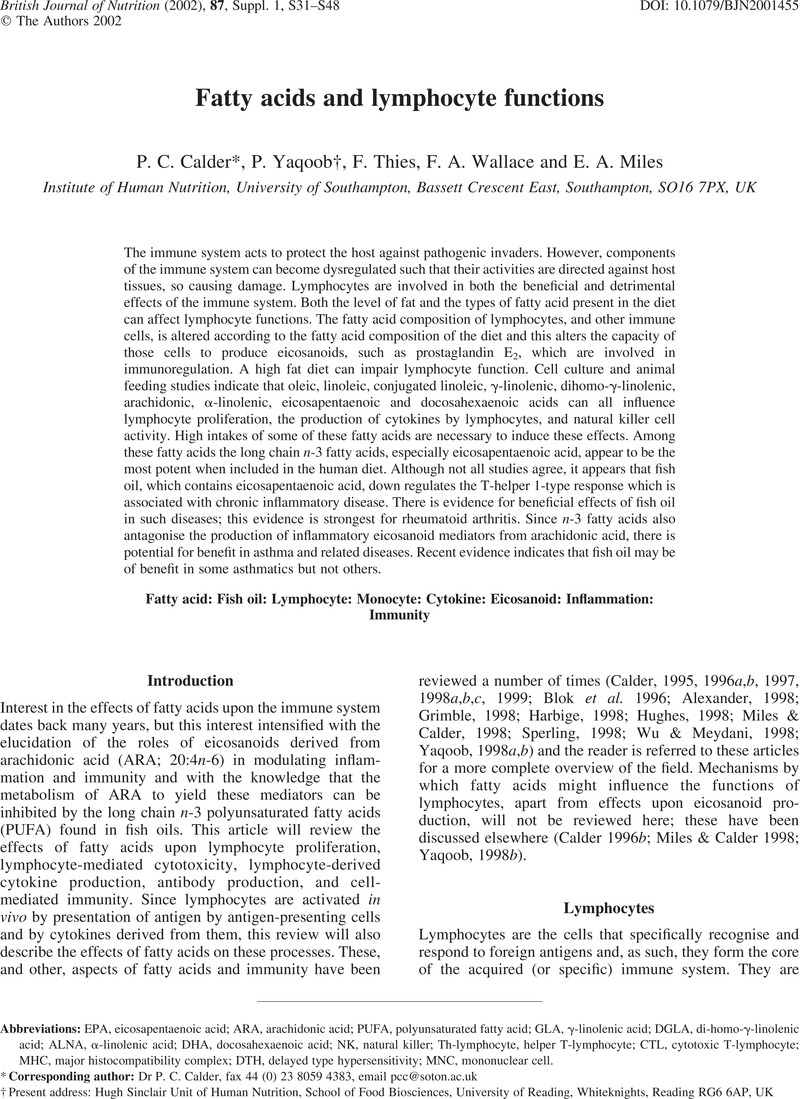Crossref Citations
This article has been cited by the following publications. This list is generated based on data provided by Crossref.
Gil, Á.
2002.
Polyunsaturated fatty acids and inflammatory diseases.
Biomedicine & Pharmacotherapy,
Vol. 56,
Issue. 8,
p.
388.
Calder, Philip C.
2003.
Do ω-3 fatty acids ease the way to silent cell death?.
Nutrition,
Vol. 19,
Issue. 5,
p.
472.
Bechoua, Shaliha
Dubois, Madeleine
Véricel, Evelyne
Chapuy, Paul
Lagarde, Michel
and
Prigent, Annie-France
2003.
Influence of very low dietary intake of marine oil on some fuctional aspects of immune cells in healthy elderly people.
British Journal of Nutrition,
Vol. 89,
Issue. 4,
p.
523.
Meletis, Chris D.
and
Barker, Jason
2003.
Natural Approaches to Controlling Inflammatory Disease.
Alternative and Complementary Therapies,
Vol. 9,
Issue. 5,
p.
232.
Denny, Sarah I.
Thompson, Rachel L.
and
Margetts, Barrie M.
2003.
Dietary factors in the pathogenesis of asthma and chronic obstructive pulmonary disease.
Current Allergy and Asthma Reports,
Vol. 3,
Issue. 2,
p.
130.
Hall, Jean A.
Tooley, Katie A.
Gradin, Joseph L.
Jewell, Dennis E.
and
Wander, Rosemary C.
2003.
Effects of dietary n-6 and n-3 fatty acids and vitamin E on the immune response of healthy geriatric dogs.
American Journal of Veterinary Research,
Vol. 64,
Issue. 6,
p.
762.
Cunningham-Rundles, Susanna
2003.
Is the fatty acid composition of immune cells the key to normal variations in human immune response?.
The American Journal of Clinical Nutrition,
Vol. 77,
Issue. 5,
p.
1096.
Kew, Samantha
Banerjee, Tapati
Minihane, Anne M
Finnegan, Yvonne E
Williams, Christine M
and
Calder, Philip C
2003.
Relation between the fatty acid composition of peripheral blood mononuclear cells and measures of immune cell function in healthy, free-living subjects aged 25–72 y.
The American Journal of Clinical Nutrition,
Vol. 77,
Issue. 5,
p.
1278.
Llor, X.
2003.
Papel de los lípidos de la dieta en los mecanismos de inflamación, proliferación, diferenciación y muerte celular en el tracto intestinal.
Gastroenterología y Hepatología,
Vol. 26,
Issue. 8,
p.
507.
Verlengia, Rozangela
Gorjão, Renata
Kanunfre, Carla Cristine
Bordin, Silvana
de Lima, Thais Martins
and
Curi, Rui
2003.
Effect of arachidonic acid on proliferation, cytokines production and pleiotropic genes expression in Jurkat cells—A comparison with oleic acid.
Life Sciences,
Vol. 73,
Issue. 23,
p.
2939.
Gil, Ángel
2003.
Is Eicosapentaenoic Acid Useful in the Treatment of Ulcerative Colitis in Children?.
Journal of Pediatric Gastroenterology and Nutrition,
Vol. 37,
Issue. 5,
p.
536.
Lessard, M.
Gagnon, N.
and
Petit, H.V.
2003.
Immune Response of Postpartum Dairy Cows Fed Flaxseed.
Journal of Dairy Science,
Vol. 86,
Issue. 8,
p.
2647.
Dunstan, Janet A
Mori, Trevor A
Barden, Anne
Beilin, Lawrence J
Taylor, Angie L
Holt, Patrick G
and
Prescott, Susan L
2003.
Fish oil supplementation in pregnancy modifies neonatal allergen-specific immune responses and clinical outcomes in infants at high risk of atopy.
Journal of Allergy and Clinical Immunology,
Vol. 112,
Issue. 6,
p.
1178.
"Li a,b", Duo
Attar-Bashi b, Nadia
and
Sinclair b, Andrew
2003.
Flaxseed in Human Nutrition, Second Edition.
Dooper, Maaike M. B. W.
Van Riel, Boet
Graus, Yvo M. F.
and
M'Rabet, Laura
2003.
Dihomo‐γ‐linolenic acid inhibits tumour necrosis factor‐α production by human leucocytes independently of cyclooxygenase activity.
Immunology,
Vol. 110,
Issue. 3,
p.
348.
Hunter, Kenneth W
Gault, Ruth A
Stehouwer, Jeffrey S
and
Tam-Chang, Suk-Wah
2003.
Synthesis of cetyl myristoleate and evaluation of its therapeutic efficacy in a murine model of collagen-induced arthritis.
Pharmacological Research,
Vol. 47,
Issue. 1,
p.
43.
Trebble, Timothy
Arden, Nigel K.
Stroud, Mike A.
Wootton, Stephen A.
Burdge, Graham C.
Miles, Elizabeth A.
Ballinger, Anne B.
Thompson, Rachel L.
and
Calder, Philip C.
2003.
Inhibition of tumour necrosis factor-α and interleukin 6 production by mononuclear cells following dietary fish-oil supplementation in healthy men and response to antioxidant co-supplementation.
British Journal of Nutrition,
Vol. 90,
Issue. 2,
p.
405.
Prescott, Susan L.
2003.
Early origins of allergic disease: a review of processes and influences during early immune development.
Current Opinion in Allergy and Clinical Immunology,
Vol. 3,
Issue. 2,
p.
125.
Gil, Ángel
2003.
Is Eicosapentaenoic Acid Useful in the Treatment of Ulcerative Colitis in Children?.
Journal of Pediatric Gastroenterology and Nutrition,
Vol. 37,
Issue. 5,
p.
536.
Mattacks, Christine A.
Sadler, Dawn
and
Pond, Caroline M.
2004.
Site-Specific Differences in Fatty Acid Composition of Dendritic Cells and Associated Adipose Tissue in Popliteal Depot, Mesentery, and Omentum and Their Modulation by Chronic Inflammation and Dietary Lipids.
Lymphatic Research and Biology,
Vol. 2,
Issue. 3,
p.
107.



